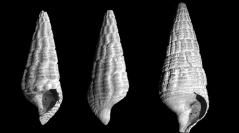

 Comptes Rendus Palevol
22 (14) - Pages 245-264
Comptes Rendus Palevol
22 (14) - Pages 245-264We analyse the distribution of the potamidid genus Terebralia Swainson, 1840 in the European fossil record (middle Eocene to Miocene). Extant Terebralia contains species restricted to mangroves and mudflats, rendering it a reliable element for detecting these coastal environments in the fossil record. Our contribution summarizes the European fossil record of this taxon and highlights the presence of this genus within coastal environments in the European realm. Distribution in the Cenozoic is interpreted based on ecological preferences, dispersal modes and climatic restrictions of recent species. Maximum geographical distribution is reached during the Early and Middle Miocene with two species being present from the southernmost parts of Europe and Anatolia to the North Sea Basin and the Paratethys. During the Late Miocene, the distribution of Terebralia lignitarum (Eichwald, 1830) is patchy and limited to the South of Europe. The Messinian Salinity Crisis coupled with a changing climate caused the disappearance of Terebralia in the Mediterranean first, and then marked the end of mangrove environments in this province.
Mollusca, Tethys, Indo-West Pacific, systematics, climate, biogeography.